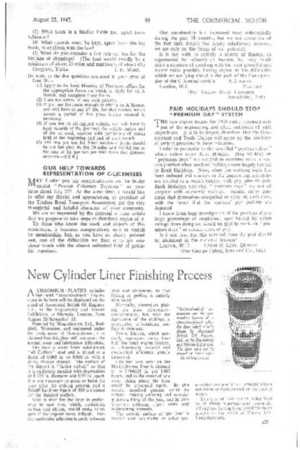New Cylinder Liner Finishing Process
Page 47

If you've noticed an error in this article please click here to report it so we can fix it.
A CHROMIUM -PLATED cylinder fl liner with " latticed-etched " depressions in its bore will be displayed on the stand of Associated British Oil Engines, Ltd., at the Engineering and Marine Exhibition, at Olympia, London, from August 28-September 13.
Patented by Monochrome, Ltd., Redditch, Worcester, and registered under the trade name of Honeychrome, it is claimed that this liner will overcome the normal wear and lubrication difficulties.
The liner is made from solid-drawn "40 Carbon" steel and is plated to a depth of 0.005 in. to 0.006 in. with a dense chrome deposit. The surface of the deposit is "lattice etched," so that it is uniformly mottled with depressions of 0.125 in. diameter and 0.25 in. apart. It is not necessary to grind or hone the liner after the etching process, and a Brinell hardness figure of 450 is claimed for the finished surface.
Steel is used for the liner in preference to cast iron, which, containing carbon and silicon, would make adhesion of the deposit more difficult. Perfect molecular adhesion is made between steel and chromium, so that flaking or peeling is entirely eliminated.
Normally, chromium plating has poor oil-retentive characteristics, but, with the depression of the etchings, a superlative oil-retaining surface is obtained.
Piston friction, which normally represents more than half the total engine friction, is substantially reduced and mechanical efficiency greatly improved.
Cylinder liner wear on the Honeychrome liner is claimed to be 0.000125 in. per 1,000 hours, and in the event of any wear taking place, the liner could be processed again. By this means, standard pistons could be refitted, making reboring and oversize pistons a thing of the past, and in consequence reducing repair costs and maintaining strength.
The outside surface of the liner is treated with bitumastic or other pre servative compound as a protection from corrosion or scale deposit of the coohne. water.
This type of liner is now being fitted to all Petter Superscavenge two-stroke oil engines, having been tested for many months in the works of Petters, Ltd., Lo ughborough.
















































































